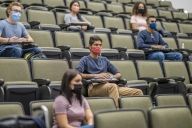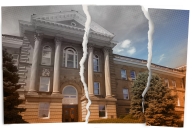You have /5 articles left.
Sign up for a free account or log in.
The U.S. Department of Education on Wednesday unveiled a proposed overhaul of a federal rule governing student loan forgiveness that would make the process more restrictive for defrauded borrowers.
The department crafted the new borrower-defense rule after blocking an Obama administration regulation from going into effect last year. Like the Obama rule, the department’s new proposal would establish a clear federal standard for borrowers who are pursuing loan discharge. But it includes numerous changes that would reduce potential relief for borrowers as well as liability for colleges.
The proposal also contemplates allowing loan forgiveness applications only for borrowers in default, which would dramatically reduce the number of students who are eligible for relief.
The Education Department issued its 2016 borrower-defense rule after a flood of claims from former for-profit college students citing a little-used provision of federal statute as their institutions neared collapse amid state and federal investigations. The Obama rule would have issued a clear federal standard for those claims for the first time. But Education Secretary Betsy DeVos said the regulation did not do enough to account for the concerns of colleges.
“Our commitment and our focus has been and remains on protecting students from fraud,” DeVos said after the release of the new rule Wednesday. “The regulations proposed today accomplish that by laying out clear rules of the road for higher education institutions to follow and holding institutions, rather than hardworking taxpayers, accountable for making whole those students who were harmed by an institution’s deceptive practices.”
Under the proposed regulation, students would be eligible for relief if they demonstrate that their institution knowingly made false statements in advertising or recruitment materials or made promises about a program with a reckless disregard for the truth -- a standard student advocate groups say would put the burden of proof on borrowers themselves.
The rule also would require that borrowers’ claims be addressed individually, rather than in a class action, as allowed under an existing rule and the 2016 rule. The department rarely, but in some cases, has granted automatic loan relief to all students who attended certain institutions.
The regulatory overhaul seeks to reduce the number of borrower claims, which began to skyrocket after for-profit chain Corinthian Colleges was flagged for financial monitoring by the department before its ultimate closure in 2015. Since then, the department has received about 138,990 total claims, it said. It argues that even with a more restrictive process, the possibility of large numbers of claims would be a deterrent to misbehavior by colleges.
The proposed changes to the borrower-defense rule would mean a reduction of almost $10.5 billion in debt relief extended to students over 10 years, the department estimates. And changes to closed-school discharge -- loan relief for students whose institution suddenly shuts its doors -- would save the government about $2.2 billion over a decade.
Senator Patty Murray, the Washington Democrat who is the ranking member on the Senate education committee, said the new proposal was evidence DeVos had prioritized corporations over students by making it harder to pursue claims against predatory for-profit colleges.
This rule would cut billions in debt relief to students who were simply trying to better themselves and instead were cheated out of their education and savings,” she said in a written statement. “This is a clear sign that students cannot rely on Secretary DeVos, and that she will continue to give predatory for-profit colleges and corporations a free pass when they mislead, cheat and defraud students.”
But Tennessee Republican Lamar Alexander, the chairman of the Senate education committee, said DeVos had made the proper course correction after the Obama administration issued overly broad and vague standards for loan relief.
“Secretary DeVos is right to propose new regulations that set important safeguards and clear standards for when a student can file a claim, so taxpayers aren’t paying for unreasonable or unsubstantiated claims of fraud,” he said.
The proposal would not codify into regulation a formula for determining the appropriate amount of loan relief for students but would give the secretary the authority to determine the level of harm in each case. Under the Obama administration, students with approved claims received full loan discharge. But DeVos in December announced a partial relief formula for approved borrower-defense claims based on the typical earnings of a student who attended a specific program.
Advocates, Colleges React to Proposal
Many of the changes in the proposed rule -- including the tougher standard for borrowers seeking relief -- were not surprising. It drops, for example, a ban on forced arbitration policies included in the Obama regulation, although it would require colleges to notify students in plain language that they enforce such provisions.
But student advocates were taken aback by the suggestion that the department could restrict the borrower-defense process only to defaulted borrowers.
Before writing the rule, the department was required to undertake a negotiated rule-making process that included stakeholders from various higher ed interest groups. Abby Shafroth, an attorney with the National Consumer Law Center who served as a negotiator, said that she could not recall anyone proposing the idea during three rounds of rule-making sessions -- including representatives from the department.
“It would mean there would be a large group of borrowers who were defrauded by their schools and should be eligible for relief but that the department would just make automatically ineligible unless those borrowers are willing to take their chances and go into default,” Shafroth said.
Default comes with a number of negative consequences for borrowers, she said, including the potential that they would have their wages garnished, tax refunds offset and credit ruined. It could also affect their ability to seek employment or be approved for housing or car loans.
The department’s proposed rule acknowledges the potential for “strategic defaults” by borrowers hoping for loan relief. Therefore, the department said it is considering continuing to accept claims from all borrowers with new limits to prevent frivolous claims.
The regulatory package also looks to reduce the number of loan-forgiveness claims known as closed-school discharge, filed by students when their institution precipitously closes.
It would extend to 180 days the window under which students could be eligible for relief if they withdrew from a college before its official closure date. Currently, borrowers who withdraw within 120 days of a school’s closure are eligible for a loan discharge. However, the rule would end automatic loan discharge for students who have not re-enrolled elsewhere within three years of a school closure. Those borrowers would instead have to proactively seek relief themselves.
And where closed colleges plan an orderly teach-out plan approved by their accreditor and state regulators, students would not be eligible for loan discharge. Student advocates said the proposal would effectively gut one route to loan forgiveness while protecting colleges, even when the reasons for closure are of their own making. But the department argued that the possibility that large numbers of small, private nonprofit colleges will close in the next decade would greatly increase the cost of loan forgiveness if institutions are not encouraged to provide quality teach-out options.
Steve Gunderson, president and CEO of Career Education Colleges and Universities, said the proposed rule would ensure strong protections for all parties involved.
“Since the concept of the rule was first proposed, our position has remained unchanged: any student at any institution who is a victim of fraud must be protected, and there must be a clear and uniform process for seeking and receiving relief. Earlier iterations of the rule did not respect the letter nor the intent of the law,” he said in a statement. “Carte blanche approval of batches of applications would only serve to cut off access and opportunity for future students.”
The rule also includes required financial protections when it determines a college is in danger of closing. Mandatory triggers including successful borrower-defense claims or a judgment against the institution in a lawsuit would require an institution to produce a letter of credit to protect taxpayers. Discretionary triggers could include an accreditor putting a college on a "show-cause" sanction -- essentially requiring the college to demonstrate why it should maintain the accreditor's approval.
The new rule would apply to loans issued beginning in July 2019.
The department is facing a tight November deadline to finalize the rule. The next step is opening the proposal to public comment over the next 30 days. In those comments, the department is asking members of the public to directly address whether it should consider only claims from borrowers in default or claims from student borrowers who believe they were misled but who are still repaying their loans.








